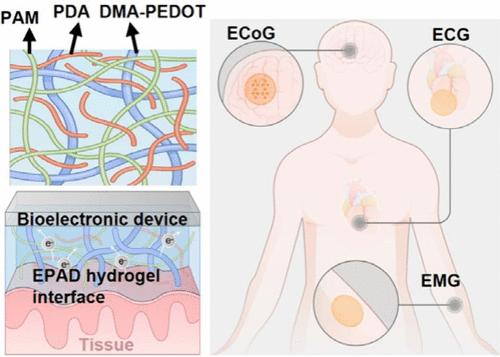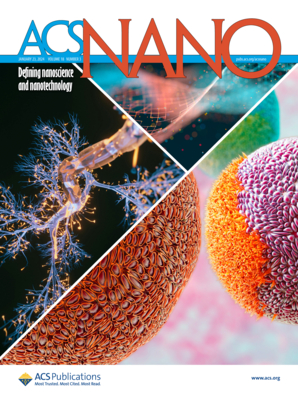Intrinsically Adhesive and Conductive Hydrogel Bridging the Bioelectronic–Tissue Interface for Biopotentials Recording
IF 15.8
1区 材料科学
Q1 CHEMISTRY, MULTIDISCIPLINARY
引用次数: 0
Abstract
Achieving high-quality biopotential signal recordings requires soft and stable interfaces between soft tissues and bioelectronic devices. Traditional bioelectronics, typically rigid and dependent on medical tape or sutures, lead to mechanical mismatches and inflammatory responses. Existing conducting polymer-based bioelectronics offer tissue-like softness but lack intrinsic adhesion, limiting their effectiveness in creating stable, conductive interfaces. Here, we present an intrinsically adhesive and conductive hydrogel with a tissue-like modulus and strong adhesion to various substrates. Adhesive catechol groups are incorporated into the conductive poly(3,4-ethylenedioxythiophene) (PEDOT) hydrogel matrix, which reduces the PEDOT size and improves dispersity to form a percolating network with excellent electrical conductivity and strain insensitivity. This hydrogel effectively bridges the bioelectronics–tissue interface, ensuring pristine signal recordings with minimal interference from bodily movements. This capability is demonstrated through comprehensive in vivo experiments, including electromyography and electrocardiography recordings on both static and dynamic human skin and electrocorticography on moving rats. This hydrogel represents a significant advancement for bioelectronic interfaces, facilitating more accurate and less intrusive medical diagnostics.

求助全文
约1分钟内获得全文
求助全文
来源期刊

ACS Nano
工程技术-材料科学:综合
CiteScore
26.00
自引率
4.10%
发文量
1627
审稿时长
1.7 months
期刊介绍:
ACS Nano, published monthly, serves as an international forum for comprehensive articles on nanoscience and nanotechnology research at the intersections of chemistry, biology, materials science, physics, and engineering. The journal fosters communication among scientists in these communities, facilitating collaboration, new research opportunities, and advancements through discoveries. ACS Nano covers synthesis, assembly, characterization, theory, and simulation of nanostructures, nanobiotechnology, nanofabrication, methods and tools for nanoscience and nanotechnology, and self- and directed-assembly. Alongside original research articles, it offers thorough reviews, perspectives on cutting-edge research, and discussions envisioning the future of nanoscience and nanotechnology.
 求助内容:
求助内容: 应助结果提醒方式:
应助结果提醒方式:


